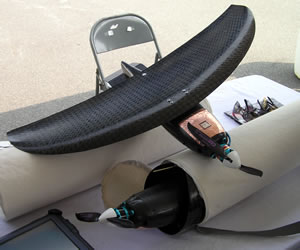 To improve mission range, persistence and raid response, some UAS are designed to be air-insertable. Since such missions could be ‘one way’ only, these UAVs are designed to be low-cost, optionally expendable systems. Among these are the the Finder from SAIC and the future SECC from Boeing. Two smaller, electrically powered UAVs also designed as optionally expendable systems, are the Coyote from ACR and Voyeur from Lite Machines as well as Aerovironment’s Switchblade. At the lower tier, unmanned systems are rapidly maturing, with some systems already fielded with US forces, particularly special forces and light infantry and airborne units.
To improve mission range, persistence and raid response, some UAS are designed to be air-insertable. Since such missions could be ‘one way’ only, these UAVs are designed to be low-cost, optionally expendable systems. Among these are the the Finder from SAIC and the future SECC from Boeing. Two smaller, electrically powered UAVs also designed as optionally expendable systems, are the Coyote from ACR and Voyeur from Lite Machines as well as Aerovironment’s Switchblade. At the lower tier, unmanned systems are rapidly maturing, with some systems already fielded with US forces, particularly special forces and light infantry and airborne units.

 Some of the latest developments shown here include the BatMav (Wasp III) micro UAV from Aerovironment, recently selected for the Pentagon’s SUAV program. Its competitor, the Nighthawk (previously known as BatCam), is undergoing continuous development and was now introduced in a redesigned, lightweight 3rd generation model. Nighthawk and the new Maverick from Prioria, both represent a new concept of an ‘always ready’ UAV carried in a tube, with wings wrapped around the fuselage. When needed, the UAV is pulled out of tube, the wings automatically snapping into position making the UAV is ready to launch.
Some of the latest developments shown here include the BatMav (Wasp III) micro UAV from Aerovironment, recently selected for the Pentagon’s SUAV program. Its competitor, the Nighthawk (previously known as BatCam), is undergoing continuous development and was now introduced in a redesigned, lightweight 3rd generation model. Nighthawk and the new Maverick from Prioria, both represent a new concept of an ‘always ready’ UAV carried in a tube, with wings wrapped around the fuselage. When needed, the UAV is pulled out of tube, the wings automatically snapping into position making the UAV is ready to launch.
Other micro-designs at AUVSI included vertical take-off and landing designs, including the new electrically powered Micro-Air Vehicle from CRG, and new turbine-based propulsion developed for the Class I Micro UAV from Honeywell.
Topics covered in AUVSI 2007 review:
- Unmanned Systems – Flight and Ground Demonstration 2007
- UAV systems, including Combat UAVs
- Mini, Micro and Expendable UAV Systems
- The future USMC Tier II program
- High Altitude Long Endurance (HALE) Platforms
- Unmanned Transport Vehicles
- Mission Control Systems & Applications
- Advanced payloads for unmanned Systems
- UGVs and Controls Systems
















